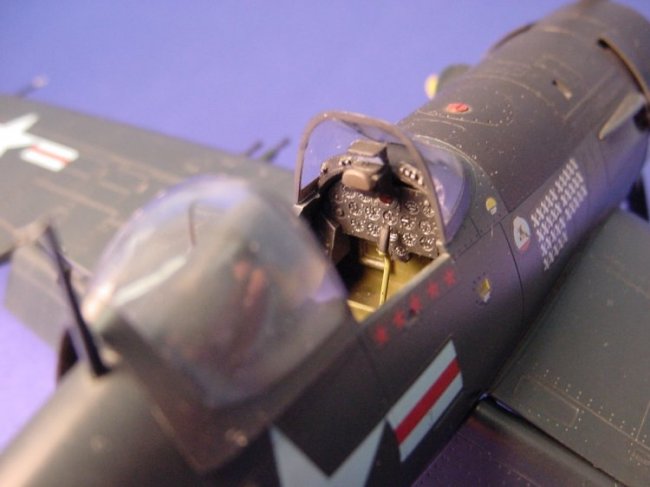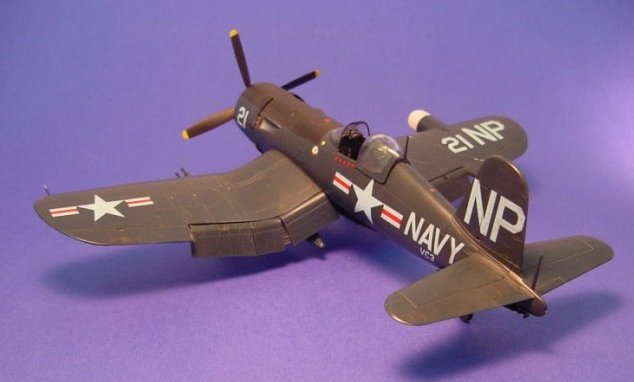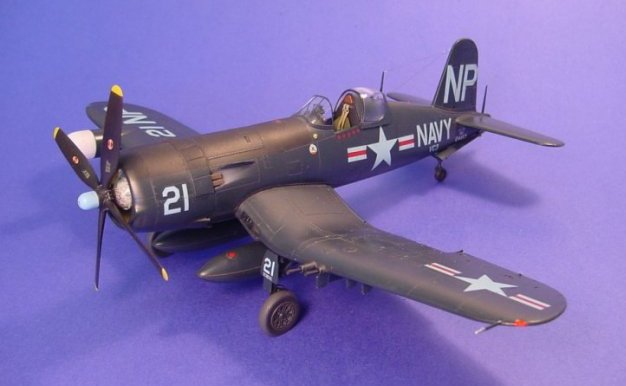|
|
1/48 Hasegawa F4U-5N Corsair
Lt. Guy P. Bordelon Composite Squadron 3 (VC-3) Korea, 1953
"LUCKY PIERRE"
Model by Will Hendriks
Photos by Steve Bamford
--------------------
|
|
As the Korean War neared its end in
the summer of 1953, North Korean night intruders, popularly known as "Bedcheck
Charlies", were causing real damage to UN facilities and supplies. These
"Bedcheck Charlies" were most often slow-moving propeller driven
aircraft, many of which were biplanes. The Airforce jets were too fast to deal
with the intruders, so a detachment of five of VC-3's Corsairs from USS
Princeton were dispatched to an airfield south of Seoul to counter the threat,
led by Lt. Guy Bordelon.
Composite Squadron 3 was specially trained and their aircraft were specially
equipped for all-weather and night operations. VC-3 was well suited to
operations in the Korean theatre, where the weather could be atrocious, with
frequent low ceilings, heavy rain, icing, and snow, as well as smoke and haze
caused by the combat conditions on the ground. Hilly terrain and a
"blacked-out" night environment added to the danger.
Within days of arriving, Bordelon scored four victories in two nights, with a
fifth following just two weeks later. When they weren't chasing intruders the
Night Corsairs were bombing and strafing North Korean ground targets (at
night!). The "Bedcheck Charlie" raids ceased, and Lt. Guy "Lucky
Pierre" Bordelon became the Navy's first Prop Ace in Korea.
The Model
The Hasegawa F4U-5N Corsair kit is one of a series of late Corsair kits released
by this manufacturer, and is a welcome addition. This said the kit is definitely
not a "Shake and Bake" model. The moldings are a little rough in some
areas with many sink marks on the fuselage sides and the wings. The fit is not
good in several areas, especially the
cowling to fuselage join. Ejector pin marks mar the detail of some parts. This
is surprising, considering the finesse of molding of, say, the Frank or the
George, which were released at about the same time. However, with a little work
the F4U-5N can be made into an impressive model.
 |
The interior was built up with the
addition of photo-etched seat belts from Reheat. I added a vent to the cockpit
floor and added a few radio and switch boxes to the otherwise featureless
cockpit sidewalls. The floor, seat, and forward bulkhead were painted Testor's
Model Master Interior Green with the rear bulkhead, side-walls, and instrument
panel Interior Black. I added scratchbuilt switchboxes to the top of the
cockpit coaming. The kit provides the wrong gunsight for the 5N. It should be a
N-20 gunsight, which looks a lot like the K-14. So I stole a K-14 from a Tamiya
P-51D kit and disguised it to look the part.
Ignition harnesses were added with
brass wire. Otherwise the engine looks great built as is. The tires were
flattened a bit with a sanding stick to give a weighted look, and brake lines
were added with .010" solder. This small diameter solder works great for
tubing and hoses, being easy to install because it is soft and flexible, and
takes paint
and superglue well. It is available in several diameters from fishing tackle
(fly-tying) supply stores.
| The final painting and finishing
was not as straightforward as I had thought: Talk about a contentious
colour topic! I had no idea of the controversy surrounding the colours on
this aircraft when I started building it! For instance, the colour of the
radome is variously described as black, white, and even pale blue! After poring for hours over dozens of available photos, text and internet sources, this was my best estimation. |
The airframe was painted overall
Testor's Gloss Sea Blue enamel, mixed 50/50 with thinner and sprayed
"wet" at 20psi. A smooth, glossy finish resulted. The radome was
painted white. Other details included a red fuel filler cap, red and blue nav
lights, and clear red beacons. The aerial was made of stretched sprue with
insulators made with white glue. A few extra antennae were added as per my refs.
The kit decals were used
throughout, and went down with no problems, with just a little Micro Set and
Sol. A light airbrush coat of Floquil Flat (which actually dries as a
smooth semi-gloss) sealed the decals and killed the high gloss finish.
 |
Weathering was accomplished with a combination of ground pastel chalk washes, artist's oils, and pastel chalks. The exhaust stain is Tamiya Buff sprayed through a card mask.
Even considering the kit's
shortcomings, I was pleased with the result. So what next? The French Navy F4U-7
in Suez markings is hard to resist.
References:
Corsair in Action, Squadron Signal Publications.
F4U Corsair in Detail and Scale, Volume II, Bert Kinzey
F4U Corsair, Frederick Johnsen, Crown Publishers
Corsair, Barret Tillman, Naval Institute Press
Wings of Fame Journal, Volume 3
http://www.acepilots.com/korea_bordelon.html
Happy Modelling
Will
 |
Photos and text © 2002 by Will Hendriks